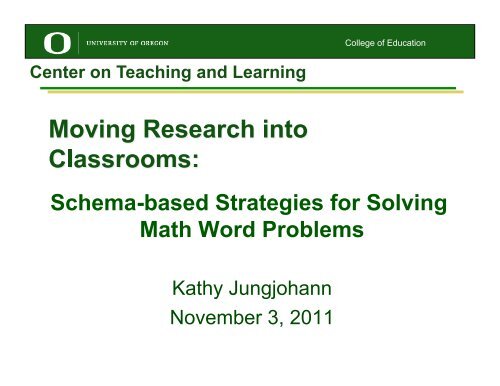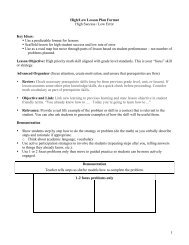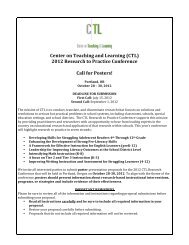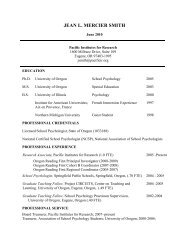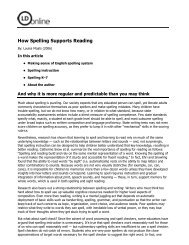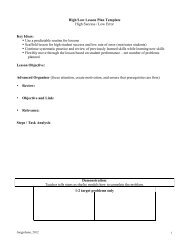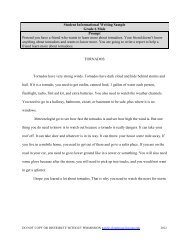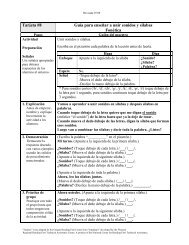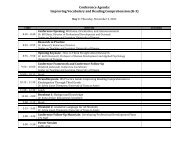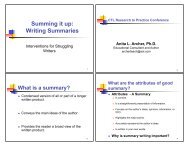Schema-based Strategies for Solving Math Word Problems
Schema-based Strategies for Solving Math Word Problems
Schema-based Strategies for Solving Math Word Problems
Create successful ePaper yourself
Turn your PDF publications into a flip-book with our unique Google optimized e-Paper software.
Recommendation 2Instructional materials <strong>for</strong> studentsreceiving interventions should focusintensely on in-depth treatment of wholenumbers in kindergarten through grade 5and on rational numbers in grades 4through 8.Level of Evidence: Low (Based on ExpectJudgment)
Recommendation 3Instruction during the intervention shouldbe explicit and systematic. This includesproviding models of proficient problemsolving, verbalization of thoughtprocesses, guided practice, correctivefeedback, and frequent cumulative review.Level of Evidence: Strong
Recommendation 4Interventions should includeinstruction on solving wordproblems that is <strong>based</strong> on commonunderlying structures.Level of Evidence: Strong
Recommendation 5Intervention materials should includeopportunities <strong>for</strong> students to work withvisual representations of mathematicalideas and interventionists should beproficient in the use of visualrepresentations of mathematical ideas.Level of Evidence: Moderate
Summary ofRecommendations• Provide explicit and systematicinstruction in problem solving…• <strong>based</strong> on common underlyingstructures…• utilizing visual representations…• at the elementary level with wholenumbers,• and at grades 4-8 with rational numbers.
How many of you have students whostruggle with problem solving?• What are some of the difficulties they have?
Typical Problem <strong>Solving</strong><strong>Strategies</strong>• Draw a picture• Make a list• Look <strong>for</strong> a pattern• Guess and check• Work backward• Use a <strong>for</strong>mulaHow do you know what strategy tochoose <strong>for</strong> a given problem?
Common Underlying Structureof Story <strong>Problems</strong>• Addition and Subtraction– Group <strong>Problems</strong>– Change <strong>Problems</strong>– Compare <strong>Problems</strong>Grades 1-2Grade 5with rational numbers• Multiplication and Division– Equal Groups– Arrays/Area– Multiplicative CompareGrades 3 - 4
Common Underlying Structureof Story <strong>Problems</strong>• Rational Numbers– Ratio– Rate– ProportionGrades 6 - 7
Teaching Addition/SubtractionStory <strong>Problems</strong> (grades 1-2)• Three Common Underlying Structures– Group <strong>Problems</strong>• aka Part/whole; Part/total; Put together/Take apart; Classification– Change <strong>Problems</strong>• aka Add to; Take from– Compare <strong>Problems</strong>• aka Difference problems
Common Core State Standards <strong>for</strong>Problem <strong>Solving</strong> 1 st -2 nd Grade1 stGrade2 ndGrade1.OA.1 Use addition and subtraction within 20 to solve wordproblems involving situations of adding to, taking from, puttingtogether, taking apart, and comparing, with unknowns in allpositions, e.g., by using objects, drawings, and equations witha symbol <strong>for</strong> the unknown number to represent the problem.1.OA.2 solve word problems that call <strong>for</strong> addition of threewhole numbers with sums less than 20.2.OA.1 Use addition and subtraction within 100 to solve oneandtwo- step word problems involving situations of adding to,taking from, putting together, taking apart, and comparing, withunknowns in all positions, e.g., by using objects, drawings, andequations with a symbol <strong>for</strong> the unknown number to representthe problem.
Group, Change, or Compare?• Dillon leaped 32 inches. Marcus leaped 27inches. How many more inches did Dillon leap?(Everyday <strong>Math</strong> 4)• Uranus has 11 rings. Neptune has 4 rings. Howmany rings do they have altogether? (SF/AW 3)• There are 18 ducks. Then 5 more swim over.How many ducks are there now? (<strong>Math</strong> Expressions 1)• Kelly bought 4 apples and 3 oranges. Howmany pieces of fruit did Kelly buy? (SF/AW 3)
Critical Features• How did you differentiate the type ofproblem?• What were the “critical features” thattipped you off?Think Pair Share
Critical Features• Group:• Change:• Compare:
Addition and Subtraction <strong>Problems</strong>Critical Features• Group– Two smaller groups/parts make up a larger group orwhole/total.• Change– Beginning quantity followed by an action thatincreases (add to) or decreases (take from).• Compare– Two things are being compared with the same unit– One thing is more, one is less, difference
Keys to Successful Problem<strong>Solving</strong>• Teach students the critical features sothey can identify and differentiate theunderlying structure of word problems.• Teach students to visually represent theseproblems aligned with their criticalfeatures.
Addition and SubtractionStructure using Strip DiagramsParts: A + B =ABTotal: CC
<strong>Word</strong> Problem Structures <strong>for</strong>Addition/SubtractionMissing Value can be A, B or CABKelly bought 4 apples and 3 oranges. How many pieces offruit did she buy? (Missing value = )CKelly bought 7 pieces of fruit that included 4 apples and someoranges. How many oranges did she buy? (Missing value = )Kelly bought 7 pieces of fruit that included some apples and 3oranges. How many apples did she buy? (Missing value = )
<strong>Solving</strong> <strong>for</strong> Missing Values• <strong>Solving</strong> with addition or subtraction depends onwhich value is missing!AKelly bought 4 apples and 3 oranges. How many pieces offruit did she buy? (Add: A+B= C)CKelly bought 7 pieces of fruit that included 4 apples and someoranges. How many oranges did she buy? (Subtract: C-A=B)Kelly bought 7 pieces of fruit that included some apples and 3oranges. How many apples did she buy? (Subtract: C-B=A)B
Visual Representation <strong>for</strong>Group <strong>Problems</strong>Large GroupSmall GroupSmall Group
Visual Representations <strong>for</strong>Group <strong>Problems</strong>• Kelly bought 7 pieces of fruit. 4 were apples and therest were oranges. How many oranges did Kelly buy?4 apples x oranges = 7 fruit• Uranus has 11 rings. Neptune has 4 rings. How manyrings do they have altogether?11 rings 4 rings = x rings
Visual Representation <strong>for</strong>Change <strong>Problems</strong>• Change is about getting more:Beginning (part)Change - gettingmore (part)= Ending (total)
Visual Representation <strong>for</strong>Change <strong>Problems</strong>• There are 18 ducks. Then 5 more swimover. How many ducks are there now?Beginning (part)18Change (part)+ 5= Ending (x ducks)
Visual Representation <strong>for</strong>Change <strong>Problems</strong>• Change is about getting lessEnding (part)Change- gettingless (part)= Beginning (total)
Visual Representation <strong>for</strong>Change <strong>Problems</strong>• There were 7 puppies in a litter. 4 weregiven away. How many puppies are left?Ending (part)xChange (part)- 4= Beginning (7 puppies)
Visual Representation <strong>for</strong>Compare <strong>Problems</strong>• Dillon leaped 32 inches. Marcus leaped 27inches. How many more inches did Dillonleap?Smallest27Differencex= Largest (32 inches)
Recommendation 3Instruction during the interventionshould be explicit and systematic. Thisincludes providing models of proficientproblem solving, verbalization ofthought processes, guided practice,corrective feedback, and frequentcumulative review.Level of Evidence: Strong
<strong>Schema</strong>-<strong>based</strong> strategyinstruction (Jitendra, 2004)• Use Explicit Instruction1. Problem Identification2. Problem Representation3. Problem Solution• Provide models of proficient problem solving.• Be systematic: Teach one type of problem ata time until students are proficient.•
Step 1: Problem Identification1. Present problems that include all knownin<strong>for</strong>mation (values) – no unknowns.2. Read the problem/story.There are 18 ducks. Then 5 more swimover. Now there are 23 ducks.3. Verbalize your thought process.– Retell the story in your own words.– Ask yourself whether it is a change problem. Does ithave a beginning, then something added or taken away,and an ending?4. Provide guided practice and corrective feedbackuntil students are proficient.
Step 2: Problem Representation1. Show students how to organize thein<strong>for</strong>mation onto a visual representation i.e.schematic diagram, strip diagram, or graphicorganizer.– Increases student conceptual understanding of theunderlying structure of the problem.2. Verbalize your thought process.– Tell how you determine beginning and endingvalues.– Tell how you determine whether the change is anincrease (add) or decrease (subtract).
Step 2: Problem RepresentationChange <strong>Problems</strong>• There are 18 ducks. Then 5 more swimover. Now there are 23 ducks.Beginning18Change5= Ending23
Step 2: Problem RepresentationChange <strong>Problems</strong>• There were 7 puppies in a litter. 4 weregiven away. Now there are 3 puppies.Ending3Change4= Beginning7
Your turnStep 2: Problem Representation1. Show students how to organize thein<strong>for</strong>mation onto a schematic diagram orgraphic organizer.2. Verbalize your thought process.– For group problems, tell how you determine theparts and the whole.– For compare problems, tell how you determinethe bigger/larger value, the smaller value, andthe difference.
Your turnStep 2: Problem Representation• Kelly bought 4 apples and 3 oranges. Shebought 7 pieces of fruit altogether.
Your turnStep 2: Problem Representation• Dillon leaped 32 inches. Marcus leaped27 inches. Dillon leaped 5 more inchesthan Marcus.
Step 3: Problem Solution1. Present problems with an unknownvalues.2. Explicitly model proficient problem solving.– Model and guide students in representingproblems with unknowns (x).– Model and guide how to translate the diagraminto a mathematical equation and solve.3. Verbalize your thought process.
Step 3: Problem Solution<strong>for</strong> Change <strong>Problems</strong>• There are 18 ducks. Then 5 more swimover. How many ducks are there now?Beginning (part)18Change (part)5= Total x“Now that I have my strip diagram filled out I can solve theproblem. When I know the parts, I can solve the problem byadding the parts to find the total. 18 + 5 = 23. So my answer is23 ducks.”
Step 3: Problem Solution<strong>for</strong> Change <strong>Problems</strong>• There were 7 puppies in a litter. 4 were givenaway. How many puppies are there now?Ending (part)xChange (part)4= Beginning (total) 7“Now that I have my strip diagram filled out I can solve theproblem. When I know the total and a part, I can solve theproblem by subtracting to find the other part. 7 - 4 = 3. Somy answer is 3 puppies.”
Your turnStep 3: Problem Solution1. Present problems with an unknownvalues.2. Explicitly model proficient problem solving– Model and guide students in representingproblems with unknowns.– Model and guide how to translate the diagraminto mathematical symbols and solve.3. Verbalize your thought process.
Your turnStep 3: Problem Solution• Kelly bought 4 apples and some oranges.She bought 7 pieces of fruit altogether. Howmany oranges did she buy?4 x= 7
Your turnStep 3: Problem Solution• Dillon leaped 32 inches. Marcus leaped 5fewer inches than Dillon. How inches didMarcus leap?x 5= 32
What other strategies can studentsuse to solve these problems?• Rule– If total missing you add.– If part is missing you subtract.
What other strategies can studentsuse to solve these problems?• Rule– If total missing you add.– If part is missing you subtract.• Manipulatives• Counting up• Missing addend• Inverse operations• Number familiesSelectsolutionstrategiesaligned withstrategiesthe studentknows howto use
Provide frequent cumulativereview• As students become more proficient:– Fade the visual representation and move tomore abstract representations.– Increase the complexity of the problemsmoving from familiar to unfamiliar problems.• Add in distractors• Multi-step problems• Use units and unit conversions(inches, pounds, minutes)• Use larger numbers / rational numbers• More difficult vocabularyContinues though the grades
Adding Distractors• There are 18 ducks and 3 frogs on a pond. 5more ducks swim over. How many ducks arethere now?Beginning ducks18Change ducks5= x ducks
Multi-step <strong>Problems</strong>• Sal saw 6 elephants, 3 giraffes, and 6 tigersat the zoo. How many animals did he see?Elephants6Giraffes3Tigers6= x animalsCCSS1 st Grade1.OA.2 solve word problems that call <strong>for</strong> addition ofthree whole numbers with sums less than 20.
Unit Conversions• Dillon leaped 2 and ½ feet. Marcus leaped27 inches. How much farther did Dillonleap?Smallest27 inchesDifferencex= 2 ½ feet (30 inches)
More difficult vocabulary andlarger numbers• A grizzly bear can weigh 786 pounds. An Americanblack bear can weigh 227 pounds. What is theircombined weight? (EM 4)Grizzly bear786Black bear227= x pounds
Common Underlying Structureof Story <strong>Problems</strong>• Addition and Subtraction– Group <strong>Problems</strong> (Part/whole)– Change <strong>Problems</strong>– Compare <strong>Problems</strong>Grade 5withrationalnumbers• Multiplication and Division– Equal Groups– Array/Area– Multiplicative CompareGrades 3- 4
Common Core State Standards<strong>for</strong> Problem <strong>Solving</strong>3 rd Grade4 th Grade5 th Grade3.OA.3 Use multiplication and division within 100 to solve wordsproblems in situations involving equal groups, arrays, andmeasurement quantities, e.g., by using drawings and equations witha symbol <strong>for</strong> the unknown number to represent the problem.4.OA.2 Multiply or divide to solve word problems involvingmultiplicative comparison, e.g., by using drawings and equations witha symbol <strong>for</strong> the unknown number to represent the problem,distinguishing multiplicative comparison from additive comparison.5.NF.2. Solve word problems involving addition and subtraction offractions…5.NF.6 Solve real world problems involving multiplication of fractionsand mixed numbers, e.g., by using visual fraction models orequations to represent the problem.5.NF.7c Solve real world problems involving division of unit fractionsby whole numbers and whole numbers by unit fractions by usingvisual fraction models and equations to represent the problem.
Underlying Structure <strong>for</strong>Multiplication/Division <strong>Problems</strong>• Equal Groups <strong>Problems</strong>– Groups, same number of items in each group, totalnumber of items• Array/Area <strong>Problems</strong>– Equal groups arranged in rows and columns, totalnumber of items– Sides (length and width) and total area• Multiplicative Compare <strong>Problems</strong>– Compares one thing as multiple of another (3 times asmany), or as a part of another (1/3 as much)
Equal Groups, Array, Area,Multiplicative Compare?• There are 240 chairs to set up <strong>for</strong> the concert. Eachrow has 40 chairs in it. How many rows are there?(Everyday <strong>Math</strong> 4)• The Sports Boosters raised $908 at their annual chilisupper. The money will be shared equally by 4athletic teams. How much money will each teamreceive? (Everyday <strong>Math</strong> 4)• Francine has 5 CDs. Millie has 3 times as many. Howmany CDs does Millie have? (SF/AW 4)• The patio in Erika’s backyard is 5 yards long by 4yards wide. How much carpet would Erika’s fatherneed to buy to cover the whole patio? (<strong>Math</strong> Exp 5)
Critical Features <strong>for</strong>Multiplication/Division <strong>Problems</strong>• Equal Groups and Array <strong>Problems</strong>– Almost always have key words “each” or “every”– Sometimes have key words “a” or “per”• Area <strong>Problems</strong>– Give dimensions of length, width, or area• Multiplicative Compare <strong>Problems</strong>– Have a multiplicative comparison statement of increase(e.g. 3 times as much/many), or decrease (e.g. 1/3 asmuch/many)
Visual Representationusing Strip DiagramsMultiplication and Division: a x b = c# of groups x number in each group = Totala = number of groupsb = # ineach groupb = # ineach groupb = # ineach groupb = # ineach groupc = TotalWhether to multiply or divide depends on whetherthe part or the total is missing.
Strip Diagram <strong>for</strong>Multiplication/Division <strong>Problems</strong>• There are 240 chairs to set up <strong>for</strong> the concert.Each row has 40 chairs in it. How many rowsare there?40 chairs/row240 chairsNow we can solve: 40 x ? = 240
Strip Diagram <strong>for</strong>Multiplication/Division <strong>Problems</strong>• There are 240 chairs to set up <strong>for</strong> the concert.Each row has 40 chairs in it. How many rowsare there?40 chairs/row40 chairs/row40 chairs/row40 chairs/row40 chairs/row40 chairs/row240 chairsNow we can solve: 240 ÷ 40 = 6 rows
Strip Diagram <strong>for</strong>Multiplicative Compare• Francine has 5 CDs. Millie has 3 times asmany. How many CDs does Millie have?MillieFrancine 5 CDs• Now we can solve: 5 x 3 = ___ CDs
Other visual representations<strong>for</strong> multiplication/division# of groups x number in each group = Total# groups X # in each group= Total
Visual Representation <strong>for</strong> EqualGroups / Array / Area <strong>Problems</strong>ArrayRows x Items/rowEqual groups= Totalitemsa b cGroups xAreaItems/group= Totalobjectsa b cLength x Width = Areaa c bMultiplicative CompareReferent xComparisonFactor= Totala b c
Visual Representations <strong>for</strong> EqualGroups / Array / Area <strong>Problems</strong>• There are 240 chairs to set up <strong>for</strong> theconcert. Each row has 40 chairs in it.How many rows are there?• The Sports Boosters raised $908 at theirannual chili supper. The money will beshared equally by 4 athletic teams. Howmuch money will each team receive?• The patio in Erika’s backyard is 5 yardslong by 4 yards wide. How much carpetwould Erika’s father need to buy to coverthe whole patio?• Francine has 5 CDs. Millie has 3 times asmany. How many CDs does Millie have?Rows x Items/row = Totalitemsx 40 240Groups xItems/group= Totalobjects4 x $908Length x Width = Area5 yds 4 yds x sq ydsReferent xComparison= Total5 3 x
<strong>Schema</strong>-<strong>based</strong> strategyinstruction (Jitendra, 2004)1. Problem Identification– Retell the problem in own words– Identify type of problem <strong>based</strong> on criticalfeatures2. Problem Representation– Draw a diagram to represent the problem– Fill in given values3. Problem Solution– Solve using solution strategies students know
Common Underlying Structureof Story <strong>Problems</strong>• Rational Numbers– Rate– Ratio– ProportionGrades 6 - 7
Common Core State Standards<strong>for</strong> Problem <strong>Solving</strong>6th Grade7th Grade6.RP.3 Use ratio and rate reasoning to solve real-world andmathematical word problems e.g., by reasoning about tables ofequivalent ratios, tape diagrams, double number line diagrams, orequations.6.RP.3b Solve unit rate problems involving unit pricing and constantspeed.7.RP.3 Use proportional relationships to solve multistep ratio andpercent problems.7.NS.3 Solve real-world and mathematical problems involving thefour operations with rational numbers.
Ratio and Rate problems• Students have been working with ratios andrates as multiplication/division problems.– There are 240 chairs to set up <strong>for</strong> the concert. Eachrow has 40 chairs in it. How many rows are there?• Extend their thinking to proportionalrelationships with visual representations.1 row = x rows40 chairs 240 chairs
Your turn – use a strip diagram tovisually represent this problem• Ratio– Lilly wants to make 10 liters of raspberrylemonade <strong>for</strong> her party. The ratio or lemonade toraspberry juice is 3:2. How much lemonade andraspberry juice will you need?
Your turn – use a strip diagram tovisually represent this problem• Proportion– Duff can make 8 cakes with 24 eggs. If he only hasto make 2 cakes, how many eggs will he need?
Your turn – use a strip diagram tovisually represent this problem• Ratio– Lilly wants to make 10 liters of raspberrylemonade <strong>for</strong> her party. The ratio or lemonade toraspberry juice is 3:2. How much lemonade andraspberry juice will you need?10 literslemonade lemonade lemonaderaspberryjuiceraspberryjuice
Visual Representation <strong>for</strong>Proportion <strong>Problems</strong>• Duff can make 8 cakes with 24 eggs. If heonly has to make 2 cakes, how many eggswill he need?cake cake cake cake cake cake cake cakeeggs• Now we can solve: 24 ÷ 8 = unit ratio (3 eggs/cake)3 eggs x 2 cakes = ? eggs
Another Visual Representation<strong>for</strong> Proportion <strong>Problems</strong>• Duff can make 8 cakes with 24 eggs. If heonly has to make 2 cakes, how many eggswill he need?If…Then8 cakes 2 cakes24 eggs x eggs8 = 224 x
Another Visual Representation<strong>for</strong> Proportion <strong>Problems</strong>• Duff can make 8 cakes with 24 eggs. If heonly has to make 2 cakes, how many eggswill he need?8 2=8 = 224 x24 x
What strategy can studentsuse to solve these problems?• Unit rate strategy: Find single unit,then multiply to find missing value• Fraction strategy: Multiply or divideby a fraction = 1 to make anequivalent fraction• Cross multiply to find missing valueSelectsolutionstrategiesaligned withstrategiesthe studentknows howto use
Visual Representation <strong>for</strong>Proportion <strong>Problems</strong>• Duff can make 8 cakes with 24 eggs. If heonly has to make 2 cakes, how many eggswill he need?8÷ 4 = 2If…Then 24 4 x8 cakes 2 cakes24 eggs x eggs24 (2) = 8 (x)• Now we can solve with equivalent fraction orcross-multiplication strategy.
Barriers / Roadblocks• Curriculum doesn’t classify problems into types– Teachers need to identify typea of problemspresented and control which types are introduced• As types become more complex, so willproblem types and task of discriminating amongthem– Teachers and students need to practice identifyingtypes of problems and justifying their responses.Teacher need to practice how to model and givefeedback on problem types.
Other Barriers / Roadblocks• Your students have learned other ways tovisually represent the problem.– Use this as an opportunity to show multipleconceptualization solution strategies.• Your curriculum uses different visualrepresentations.– Evaluate the visual representation• Does it link to conceptual understanding of the problemstructure?• Can it be used to represent a range of this type ofproblem?
BIG IDEAS• Provide explicit and systematic instruction inproblem solving.• Teach common underlying structures ofword problems.• Use visual representations.• Verbalize your thought process.• Model proficient problem solving, provideguided practice, corrective feedback, andfrequent cumulative review.
From Pro-ed• Teaching Students withLearning Disabilities Using<strong>Schema</strong>-Based Instruction• By Asha K. Jitendra• Note: Different visualmodels• ISBN 978-1-4164-0245-9
College of EducationCenter on Teaching and Learning<strong>Schema</strong>-<strong>based</strong> <strong>Strategies</strong> <strong>for</strong><strong>Solving</strong> <strong>Math</strong> <strong>Word</strong> <strong>Problems</strong>Questions?Thank you!


